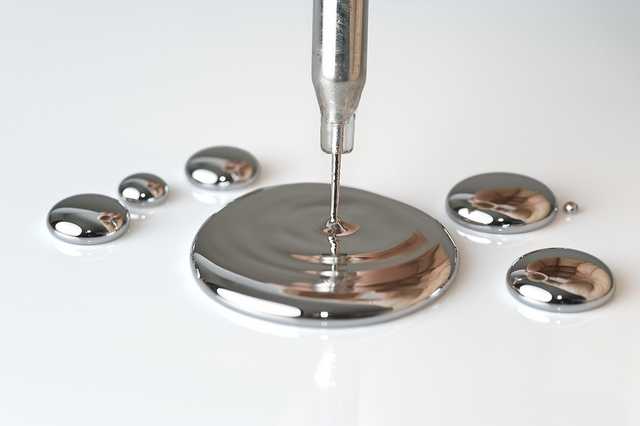
Mercury has been found in 3500 year old Egyptian tombs and was known to the ancient Chinese and Hindus. This element is not often found free in nature and is mostly obtained from the mineral cinnabar.
About half of the world’s supply of Mercury is produced in Italy and Spain. Mercury can be used to make barometers, thermometers as well as other scientific instruments. It conducts electricity and is used to make position dependent, silent switches. Mercury vapor is used in advertising signs, fluorescent lamps and streetlights.
This element easily forms alloys with other metals, such as cadmium, zinc, silver and gold. These alloys are called amalgams and are used to help extend the life of cry cell batteries, create dental fillings, and help extract gold from its ores. When combined with other elements, Mercury forms useful compounds. Mercurous chloride, also known as calomel, is an antiseptic which is used to kill bacteria. Mercuric chloride, a poisonous salt, was once used to disinfect wounds.
Mercuric oxide is used in order to make mercury batteries. Mercuric sulfide is used in order to make a red paint pigment, which is called vermilion. Mercury is poisonous and can enter our bodies through the digestive tract, the respiratory tract or directly through the skin. This poisonous element accumulates in the body, eventually causing death or severe illness.
Common uses
The use in the preparation of chlorine is Mercury’s most important use. By passing an electric current through sodium chloride, chlorine is produced. However, there is a problem with using this method, because sodium is a very reactive metal. The sodium will react violently if any water is present. For this reason, the production of chlorine is much more difficult. But, two English chemists developed a method for solving this problem in 1892. Chemists made a container with a layer of Mercury on the bottom.
The electric current produces sodium, it dissolves in the Mercury and forms an amalgam, because sodium is unable to react with water. For a number of years, this method was very popular for producing chlorine. Today, however, many companies are looking for other ways to produce chlorine. Many of them are worried about the harmful effects of this element. In addition, they are also concerned that it can get into the environment and harm plants, animals, and people. The second most important use of Mercury is in switches as well as other electrical applications.
However, many companies are switching to electronic switches, because there are increasing concerns about the health effects of Mercury. Fluorescent lamps are one application in which concerns about mercury have had little effect. These lamps contain mercury vapor. An electric current passes through the mercury vapor when fluorescent lamp is turned on, causing it to give off invisible radiation. Furthermore, the radiation strikes the inside of the glass tube, but its walls are coated with a phosphor. This material gives off visible light when struck by electrons.
As a result, the tube glows as the radiation strikes the phosphor. A number of lamp manufacturers have reduced the amount of Mercury in their lamps by about 60%. These companies have developed ways to make the fluorescent lamps work just as well with less Mercury. But, mercury lamps are preferred choice. Today, each lamp contains much less mercury. However, there are many more fluorescent lamps than ever before. Mercury batteries were quite popular for a time. More than 1,000 tons of Mercury were used each year to make mercury batteries in the early 1980s.
However, these batteries are a special environmental problem, because people tend to throw them away when they no longer work. Mercury is released into the environment, because the cases split open easily. For this reason, much less Mercury is used to make such batteries. In addition, Mercury is also used in dental applications, coatings for mirrors, and measuring instruments, such as mercury barometers and thermometers.



